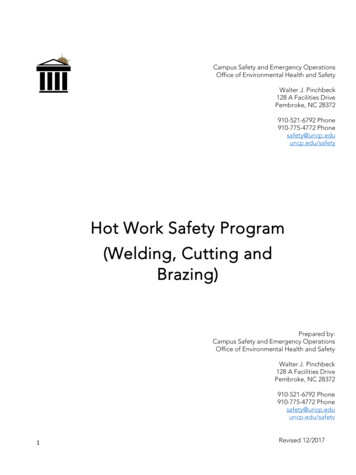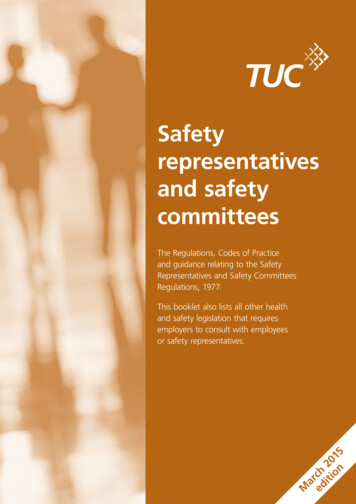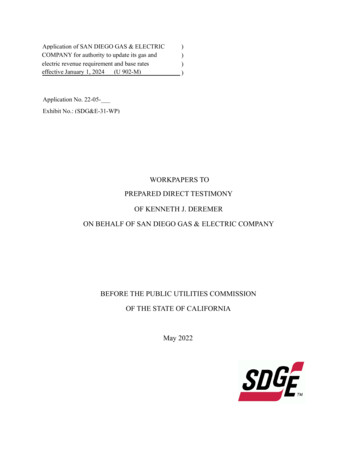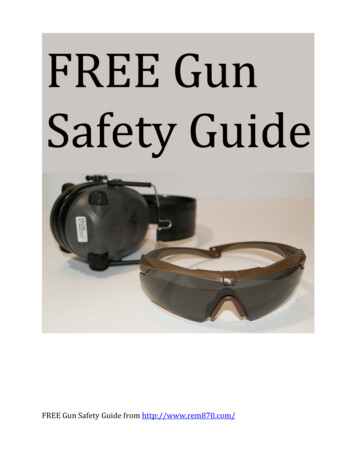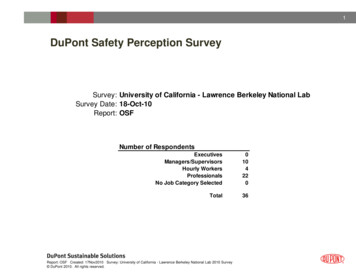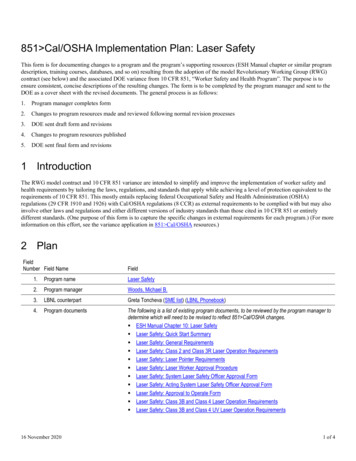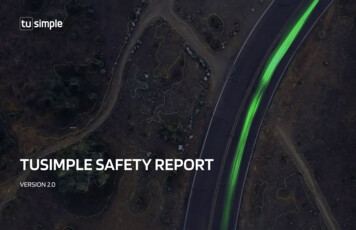
Transcription
TUSIMPLE SAFETY REPORTVERSION 2.0
TABLE OF CONTENTSTUSIMPLE SAFETY REPORTCONTENTSCHAPTER 1INTRODUCTIONCHAPTER 2ELEMENTS OF SAFETYAppendix4Our Mission12 System Safety32 Glossary 5About Us14 Operational Design Domain 33 End Notes7Safety and Workforce Issues Facing the Trucking Industry15 Object and Event Detection and Response 8Landscape for Autonomous Trucks16 Fallback (Minimal Risk Condition) 9Our Autonomous System17 Validation Methods 21 Human Machine Interface 22 Vehicle Cybersecurity 23 Crashworthiness 24 Post-Crash ADS Behavior25 Law Enforcement Liaison Program26 Combating Human Trafficking27 Data Recording 28 Consumer Education and Training29 TuSimple In the News 31 Federal, Local, and State Laws2
CHAPTER 1INTRODUCTION
OUR MISSIONIncrease Safety Decrease Transportation Costs Reduce Carbon Emissions
CHAPTER 1 INTRODUCTIONTUSIMPLE SAFETY REPORTABOUT USTuSimple is an autonomous driving technology company headquarteredin San Diego, and operates a fleet of autonomous trucks out of Tucson,Arizona and Dallas, Texas. Founded in 2015, TuSimple is developing acommercial-ready Level 4 (SAE) fully autonomous driving solution forlong-haul heavy-duty trucks. For more information, please visit www.tusimple.com, and follow us on Twitter, YouTube, and LinkedIn. To learnmore about AV testing around the United States and TuSimple pleasecheck out AV TEST Initiative.TuSimple aims to transform the 800 billion U.S. trucking industry byenhancing safety, increasing efficiency, and significantly reducingoperating costs. Today, TuSimple operates a fleet of 50 autonomoustrucks on the TuSimple Autonomous Freight Network.5
CHAPTER 1 INTRODUCTIONABOUT USTUSIMPLE SAFETY REPORTCompany HistorySEP 2015Founded with headquarters in San Diego, CA.SEP 2016Awarded ten world records for autonomous driving on the Karlsruhe Institute of Technology and Toyota Technological Institute (KITTI)and Cityscapes public datasets.AUG 2017Opened testing and development facility in Tucson, AZ and began testing the TuSimple Autonomous Driving System (TADS) betweenTucson, AZ and Phoenix, AZ.FEB 2018Expanded to a new 50,000 sq ft production facility in Tucson, AZ to house our truck fleet.AUG 2018Began hub-to-hub autonomous hauling for customers in Tucson, AZ.DEC 2019University of California San Diego study found TuSimple trucks at least 10% more fuel efficient than traditional trucks.JUL 2020Strategically partnered with Navistar and ZF to co-develop SAE Level 4 autonomous semi-trucks targeted for production by 2024.JUL 2020Launched the Autonomous Freight Network, an ecosystem consisting of autonomous trucks, digital mapped routes, strategicallyplaced terminals, and TuSimple Connect, a cloud-based autonomous operations oversight system.SEP 2020Entered into a global partnership with TRATON GROUP to develop program to operate the first SAE level 4 autonomous hub-to-hubroute between Södertälje to Jönköping in Sweden using Scania trucks.NOV 2020Designed initial wear studies with strategic partner, The Goodyear Tire & Rubber Company, to understand how autonomous trucksand tires can help predict better maintenance, understand tire longevity, and reduce the fleet carbon impact.6
CHAPTER 1 INTRODUCTIONTUSIMPLE SAFETY REPORTSAFETY AND WORKFORCEISSUES FACING THETRUCKING INDUSTRYTuSimple’s autonomous driving technology can help improve safetyand address the driver shortage.The average age of truck drivers in North America is 46-50years.The truck driver shortage is projected to reach 105,000 by2023; 160,000 by 2028.During the third quarter of 2020 there was a 74% driverturnover rate at small carriers and 92% turnover rate atlarge carriers.On average, there have been 3,743 fatal crashes and over80,000 injury crashes per year involving large trucks since2010.More than 50,000 drivers were disqualified by the Drug andAlcohol Clearinghouse in 2020.On average, there have been over 290,000 propertydamage only crashes per year involving large trucks since2010.In 2020, 100,000 fewer commercial driver’s licenses (CDLs)were issued than prior years due to CDL school and licensebranch closures.At least 1 driver-related factor was recorded for all fatalcrashes involving large trucks in 2018.7
CHAPTER 1 INTRODUCTIONTUSIMPLE SAFETY REPORTLANDSCAPE FORAUTONOMOUSTRUCKSLong-haul trucking, generally recognized as routes requiring goodsAs this past year has shown us the vulnerabilities across our supplyto be delivered further than 250 miles from the truck’s origin, is anchains, we are optimistic about the opportunity for autonomousessential and significant portion of the U.S. economy and is facing atrucking to help our food system become more robust and sustainable.number of safety and economic issues.About 30-40%2 of our food supply goes to waste with spoilage beingone of the top reasons3. Additionally, food represents about 26% 19/201906-tu-simple.htmlTuSimple believes that our autonomous driving solution can help theglobal greenhouse (GGH) emissions4. It is startling to see how foodindustry mitigate or eliminate some of the most pressing issues inwaste unnecessarily contributes to global warming. By providingtrucking, such as driver retention and shortage, vehicle parking, trafficincreased freight capacity and reduced transportation times, we arecongestion and safety, while maintaining the cost and convenienceexcited about our role in helping America tackle its climate and foodadvantages the trucking industry relies on to be America’s preferredwaste challenges.https://www.usda.gov/foodwaste/faqs#: :text 20the%20food%20supply.freight movement ste-america/#: :text 0in%20America&text 0inside%20US%20landfills.We are proud to spearhead efforts to understand how autonomy data#: :text dytruck-driver-pay-is-on-the-rise#: :text ers%2C%20ATA%20said.GROWING FREIGHT DEMAND AND INCREASING COSTS5 be a net-add to our communities. Not only have we concluded thatautonomous trucks can benefit drivers, but we have also investedNearly 72.5% of domestic freight tonnage in the U.S. was movedby truck in 2019. resources to prepare drivers for a career in this budding industry. WeThe annual shipping tonnage in America requires over 3.91 millionClass 8 trucks and over 3.6 million truck drivers in 2019.have recently partnered with Pima Community College1 to create an Freight volumes are projected to increase 35.6% from 2018 to 2029.6education program that equips truck drivers with the skills needed to Total tonnage may reach 21.7 billion tons by 2029.be successful in the autonomous trucking industry. Our students will The mean compensation for truck drivers in 2019 grew by 11.5% tobe prepared for new jobs such as training the autonomous system as 58,000 compared to 2017 levels.7test drivers, operating the vehicle in situations where autonomousdriving is not suitable and to remotely monitor the system from acommand center. We are proud that eight students have completedthe course so far and are on track to be certified for employment.8
CHAPTER 1 INTRODUCTIONTUSIMPLE SAFETY REPORTOURAUTONOMOUSSYSTEMTuSimple believes in using cutting edge perception technology toand detection at medium- and short-range, while our radar sensorsdevelop the world’s safest autonomous truck. We’re building a full-offer tertiary perception and detection at medium- and short-range.stack solution and enabling autonomous trucks to improve shippingHD MAPtimes for goods and materials and to make highways safer and lessLarge trucks, like the Class-8 trucks our system is designed for andcongested. Our system uses an array of perception and localizationused on, require significantly more stopping distance and time thansensors and data along with our proprietary deep-learning detectionpassenger vehicles. At 65 MPH, we believe a large truck perceptionalgorithms to detect and track objects in real time and make pixel-levelsystem requires 300 to 500 meters of perception range, whereinterpretations within the field of vision. With this technology, a truckperception means reliable detection, classification, localization, andcan achieve a decimeter-level of positioning accuracy — even whentracking. Because a combined and integrated sensor suite that cannotin a tunnel or under a bridge.reliably perceive the critical 300- to 500-meter range is not sufficientfor a heavy vehicle traveling at highway speeds, we have designed ourPLANNINGLOCALIZATIONUsing our sensor array and deep-learning algorithms, our proprietarysensor array to perceive at a much larger distance of 1,000 meters toartificial intelligence (AI) decision-making system can guide vehiclesensure reliable determination in the critical safety range and addedalong a safe and fuel-efficient route based on terrain and real-timeefficiency. Our 1,000-meter perception range allows the autonomousroad conditions. Our solution has been purpose-built to provide asoftware to make long-range, proactive, and strategic decisions torobust perception system, allowing the decision-making AI to actimprove safety and efficiency beyond what other systems can achieve.with high confidence and detection reliability. Our n system operates more safely at highway speeds becauseIn addition to cutting-edge technology and advanced algorithms, it isthe sensor array is optimized for use on Class 8 tractors and providesimportant that autonomous systems are designed, manufactured, andredundant secondary and tertiary perception, detection, and trackingused in accordance with exceedingly high safety standards. That is whydata. To provide high confidence and reliable long-, medium-, and short-we are building International Organization for Standardization (ISO)range perception, we use a variety of sensors that allow our system to26262 into every aspect of our system, hardware, software, purchasing,detect and track objects at distances of up to 1,000 meters. Our lightand production processes and are designing to meet the stringentdetection and ranging (LiDAR) sensors provide secondary perceptionISO/PAS 21448 SOTIF (safety of the intended function). In support of9
CHAPTER 1 INTRODUCTIONTUSIMPLE SAFETY REPORTOURAUTONOMOUSSYSTEMthese, we will be registered to International Automotive Task Force(IATF) 16949, the Automotive Quality Management System. IATF willinclude the required documented supporting processes.This Voluntary Safety Self-Assessment describes our safety processesand features and the progress we’ve made implementing them. Oursafety assessment follows the U.S. Department of Transportation (DOT)and National Highway Traffic Safety Administration (NHTSA) guidelineslaid out in Automated Driving Systems 2.0: A Vision for Safety and isorganized in two parts. In this first chapter, we introduced TuSimple,our autonomous driving system, and our approach to safety. In thenext chapter, we address the 12 safety elements that the DOT andNHTSA highlight in their guidelines.10
CHAPTER 2ELEMENTS OF SAFETY
CHAPTER 2 ELEMENTS OF SAFETYTUSIMPLE SAFETY REPORTSYSTEMSAFETYThe primary goal of our autonomous system is to reduce the dangerposed to humans around us. By removing the human operator fromour commercial product, we can eliminate errors such as those causedby driver fatigue or distraction. We also continue to evaluate theperformance of our system throughout the development and test cycleto identify improvements which are then tested, verified, and includedFAILin software updates on all of our trucks. Unlike autonomous systemsthat are designed for vehicles that carry passengers, our system will becapable of operating without human intervention. Because our systemSoftwareDevelopmentSoftware Release is tested through:Unit tests & SimulationRelease is testedon test trackwill operate without occupants, our design is primarily concerned withthe safety of other drivers in its operational environment.PASSPASSWe understand the importance of using a System Safety approach toeliminate unreasonable safety risks and to mitigate risks that cannotSafety Operators and SafetyEngineers are trained on therelease features and changesBuild moves to initialpublic road testsbe fully eliminated. We’ve incorporated well-established standardsand processes into the design of every element of our autonomoussystem. We adhere to internationally recognized standards includingrelevant standards, recommended practices and guidance from theDEVELOPMENT AND TESTING CYCLEDOT, aerospace, and military to inform the design, sourcing, verification,and validation of every element of the autonomous system. Followingthe process outlined in ISO 26262 (Functional Safety – Road Vehicles),we begin by engaging in a requirements analysis to clearly develop theItem Definition. This becomes the basis for the Hazard Analysis and RiskAssessment (HARA) to identify Safety Goals and assign Automotive12
CHAPTER 2 ELEMENTS OF SAFETYTUSIMPLE SAFETY REPORTSYSTEMSAFETYAutomotive Safety Integrity Levels (ASIL) to every identified hazard andteams through detailed and rigorous fault-tree analysis, Failure Moderisk so that we can design, build, and implement mitigation, redundancy,and Effects Analysis (FMEA), and all system testing and validation. Forand/or ASIL decomposition strategies that will avoid potential failuremore information about our specific testing and validation strategiesmodes or mitigate the negative consequences of a potential failure.and practices, refer to the Validation Methods section in this document.TuSimple has a robust safety program regarding DOT compliance andIn addition, we are referencing additional state-of-the-art safetypublic safety standards, TuSimple has taken the initiative to hire twostandards and guidelines, such as ISO 21448 Safety of The Intendedsafety experts, a DOT expert and a retired law enforcement executiveFunction, UL 4600 Standard for Evaluation of Autonomous Products,who are Subject Matter Experts (SMEs) in their areas of expertise.and industry research papers and studies from leading automotiveISO 26262IATF 16949ISO/PAS 21488Functional Safety – Road VehiclesAutomotive Quality Management Systemcompanies and academia with efforts to develop safety envelopesDOT safety and compliance standards are overseen by a DOT expert.around the development, testing, and deployment of machine learningTuSimple is building pre-launch inspection protocols with the supportalgorithms. Furthermore, we are implementing progressive safetyof third-party auditors that rise to the level of the commercial airlinemethodologies used in aerospace and military to effectively analyzestandards and meet or exceed minimum inspection requirements setthe high level of complexity of our software, such as System Theoreticforth by the Federal Motor Carrier Safety Administration (FMCSA), DOTProcess Analysis.and Commercial Vehicle Safety Alliance (CVSA). All drivers have daily,weekly, and monthly reviews of their performance, and any safetyRoad Vehicles - Safety of the Intended FunctionalitySTANDARDS WE UTILIZEOur Functional Safety and Quality team is led by safety experts withviolations are addressed quickly by our SMEs. TuSimple sets the bardecades of experience in the automotive industry. This team is directlyhigher than CVSA/FMCSA standards to ensure we are one of the safestresponsible for all safety-related issues and helps lead the engineeringfleets on the road.13
CHAPTER 2 ELEMENTS OF SAFETYTUSIMPLE SAFETY REPORTOPERATIONALDESIGNDOMAINWe are developing an automated driving solution for trucks that willstatements to define the limits under which the system is allowedoperate at SAE Level 4 (L4). An L4 autonomous vehicle is able to operateto operate. ODDs must take into account road types and conditions,autonomously without a driver present only within a well-definedweather, topographic features, speed limits, and traffic laws, and otheroperational design domain (ODD). Autonomous systems, much likejurisdictional regulations.human drivers, have limitations that affect how well they perform ina variety of situations. The ODD for an L4 autonomous system definesOur ODD definition includes highways and surface streets from depotits operating limitations and excludes scenarios and situations forto depot during night and day and during inclement weather. It alsowhich an effective technical solution has not yet been validated. Forincludes parameters for road types, geographic and topographicinstance, a system might not be able to meet performance requirementsfeatures, speed limits, laws, and regulations. Our commercially deployedon snowy, high-grade, mountainous roads, so the system would notautonomous system is intended to operate under a variety of conditionsbe authorized to operate in that domain. ODDs can be extremelyand will have an ODD that confines the system to previously mappedbroad (such as interstate highways in clear conditions) or extremelyroutes validated to the ODD.narrow (such as a defined segment of a specific highway during certainhours), but they must be specific and use clear and unambiguous14
CHAPTER 2 ELEMENTS OF SAFETYTUSIMPLE SAFETY REPORTOBJECT ANDEVENT DETECTIONAND RESPONSEEvery driver relies on their senses to perceive the world around them.provide the time and space for a tractor trailer to safely and smoothlyThey use the information acquired through their senses, along with theircomplete maneuvers. In addition to the high-integrity detection in theprevious experiences and knowledge, to predict the behavior of others300- to 500-meter range that our sensor suite provides for safety aton and around the road and to make driving decisions. Autonomoushighway speeds, our 1,000-meter forward camera extends our system’ssystems are no different. Our autonomous system uses sensor solutionsrange by an additional 500 meters, which allows our planning systemto perceive and determine a safe and appropriate vehicle command.to make the safest and most efficient decision possible.Our system detects, tracks, and predicts the behaviors of objects. Oursystem tracks and resolves dynamic objects to ensure that they areWe collect massive amounts of real-world sensor data from our trucksno longer associated with risks. Our autonomous system uses thesewhich we use to train the autonomous system to detect and classifyinputs to make appropriate driving decisions for the given situation.objects it could encounter and to anticipate the behaviors of detectedobjects. Our robust prediction system considers future actions of everyOur autonomous system is capable of identifying and tracking variousdetected object in the environment. It assigns probabilities to eachstatic and dynamic objects it encounters. We use an array of sensorspotential action for each detected object and uses this set of predictionsincluding high definition cameras, LiDAR, radar, ultrasonic sensors, GPS,to choose and execute a trajectory that maximizes the probability ofinertial measurement units (IMUs), and audio sensors for long-distancea safe outcome. This allows us to have the safest possible course ofsensing in a high-speed environment under a variety of conditions. Theaction available to the autonomous system, depending on the actionsdistance penetration and clarity of our sensor solution is necessary toof other drivers and pedestrians and the surrounding infrastructure.15
CHAPTER 2 ELEMENTS OF SAFETYTUSIMPLE SAFETY REPORTFALLBACK(MINIMAL RISKCONDITION)No automated driving system can be entirely free from faults, potentialinternal system faults and external conditions to provide input to thefailures, or changes in conditions that might place it outside of itsFunctional Safety module which will choose an appropriate Functionaloperational design domain. Our automated driving system is designedSafety response and, when necessary, perform appropriate actionsto identify and safely react to these events. To safely react to situationsto achieve an MRC ranging from logging an event for degradationthat limit the autonomous system’s capabilities or changes in roadway,analysis through performing a safe emergency stop and park. Withweather, or other conditions outside the system’s operational designfail-operational functionality, our system can determine whether todomain, the system must be able to detect the critical event or changecontinue to operate under more restricted operational parametersin conditions and to perform a fallback, or minimal risk conditionor if it must stop operating immediately.(MRC), maneuver in response. Our system constantly monitors thehealth of every safety-critical component and validates all data andWe’re building fault-tolerance and fail-operational capability intotimestamps through checks and redundancies to detect scenarios inour autonomous system by using proven practices and frameworkswhich an MRC maneuver is required.developed for automotive, aerospace, and military applications toimprove the reliability and safety of our autonomous system. ToDuring the development phase, our automated driving system willreduce the likelihood of system failure, we design for reliability, self-recognize and attempt to perform most MRC maneuvers, but in somediagnostics, self-correction, and redundancy where necessary. Wecases the Safety Operator will be asked to assume control of the vehicle.perform extensive testing to evaluate the reliability of every componentTuSimple’s Safety Operator program, which includes training, testing,of the system and implement 3-tier redundancy whenever possible.continuous education, monitoring and strict policies, combined with theWe also perform fault analysis to develop a fault mitigation plan thatdesign of TuSimple’s development phase automated driving system,covers the risks identified in our HARA. All safety mechanisms, faults,help to ensure that this is a highly controllable disengagement ofand fault tolerances are validated as is required to meet our functionalthe autonomous system. After the system is functionally complete,safety goalsautomated MRC maneuvers have met functional safety goals, and thesystem has been validated, the Safety Operator will not be required.Instead, our commercial-intent autonomous system will detect both16
CHAPTER 2 ELEMENTS OF SAFETYTUSIMPLE SAFETY REPORTVALIDATIONMETHODSThroughout the system design process, we identify functionalteam of our Safety Operators and Safety Engineers. Whenever a newperformance requirements and the hazards and risks that could resultsoftware release is made available to the TuSimple fleet, our Safetyfrom misbehaving functions. We perform a full Design VerificationOperators and Safety Engineers are provided with detailed systemPlan and Report (DVP&R) of functions, maneuvers, scenarios, andbehavior-oriented release notes and face-to-face meetings are helddegradation scenarios. Electrical/electronic (E/E) devices receive fullwith the development engineering teams to review the changes andrational automotive tests, including electronic emissions. To limit publicdiscuss their implementation. To pass our verification and validationexposure to unnecessary risk, we use computer simulation testingtesting, each update to our system must achieve stringent reliabilitybefore moving to test track/proving ground testing, then finally moveand confidence levels that are derived from well-developed automotiveto road-level testing with Safety Operators after the system has passedindustry standards.the previous two phases of testing. Data from each testing phase isanalyzed and used to develop further improvements to the system.Hardware components, including sensors, motherboards, graphicsprocessing units (GPUs), and central processing units (CPUs) are testedfor their reliability and their performance before integration into ouron-vehicle system. Similarly, each software module must pass rigorousregression tests including intensive simulation-based tests that verifythe performance of the code against previous iterations before it isinstalled on our vehicles. After the individual modules and componentspass their respective unit tests, we perform a series of simulationsVERIFICATION AND VALIDATIONand closed-road track tests to verify the performance of the system.Only after the system has successfully passed the unit, simulation,and closed-road track tests is it allowed to operate on public roads.All public road tests of our developmental systems are conducted by aWe follow the design V-diagram with the design creation from system to component onthe left side of the V and the verification and validation from the component to the systemon the right side.17
CHAPTER 2 ELEMENTS OF SAFETYVALIDATIONMETHODSTUSIMPLE SAFETY REPORTSafetyOperatorsDuring the development period, our autonomous Class 8 trucks arelogging devices, real time driver alerts, inward and outward facingoperated by a 2-person team consisting of a trained Safety Operatorcameras and Advanced Driver Assistance Systems (ADAS) from industryand a Safety Engineer. Our Safety Operators are all CDL Class A licensedleading third-party vendors.drivers who are responsible for maintaining control of the vehicle atall times, disengaging the autonomous system when necessary, andmanually operating the vehicle in the case of an autonomous systemdisengagement.Hiring and QualificationsWhenever the system will be in autonomous mode, the Safety Engineersare responsible for communicating road and system information to theSafety Operator, monitoring the autonomous system, and recordingnotes about system and road conditions by voice recording and alaptop. Our Safety Operator will continuously confirm and verify allroad conditions, traffic patterns and potential risks with the SafetyEngineer in real time, remaining vigilant throughout the drive. Whiledriving, all TuSimple trucks ensure safe operation by using electronicBefore Safety Operators are hired they must pass a background check,have a clean driving record, prove they possess a CDL Class A license, beSmith System certified, and pass a road test administered by the LeadSafety Operator. Safety Engineers must also pass a background check,have a clean driving record, and pass a series of on-site interviewswhere they are asked to display their engineering and critical thinkingskills by responding to a number of challenging scenarios.18
CHAPTER 2 ELEMENTS OF SAFETYVALIDATIONMETHODSTUSIMPLE SAFETY REPORTSafetyOperatorsTraining Program for Safety Operators and EngineersThe TuSimple autonomous vehicle operation training program isWe ensure the classroom to job knowledge transfer through extensivedesigned for the Safety Operators and Safety Engineers to operatepractical training of Safety Operators and Safety Engineers via missionthe autonomous vehicles using the guiding principles of safety,observations, job shadowing, closed track training, and hands-oncommunication, and teamwork. The classroom learning objectivestraining. Our trained instructors provide continuous coaching andcover the company’s safety policies, procedures, and practices, andmentoring based on rigorous evaluation of Safety Operator and Safetyvehicle inspection and emergency protocol. To help prioritize systemEngineer performance.safety issues, the Safety Engineers are required to take the TuSimpleASIL-Based Prioritization System (ISO 26262). To effectively isolatepotential vehicle safety issues during potential pre- or post trip safetyinspection failures, Safety Operators and Safety Engineers are trainedon the TuSimple Vehicle Lockout and Tagout policy course meetingOSHA’s Control of Hazardous Energy standard.19
CHAPTER 2 ELEMENTS OF SAFETYVALIDATIONMETHODSTUSIMPLE SAFETY REPORTSafetyOperatorsContinuous EducationStrict Policies and MonitoringSafety Operators and Safety Engineers hold debrief meetings afterSafety Operators and Safety Engineers are expected to follow allroad tests to discuss system performance, identify corner cases andcompany safety policies. The cabin’s audio and video recordings areunusual scenarios, and provide feedback to product and engineeringconstantly reviewed to ensure both Safety Operators and Safetyteams. Whenever a new software release is made available to the fleet,Engineers are following company policies. Violations of companySafety Operators and Safety Engineers are provided with detailed,safety policies or changes to driving records may result in disciplinarysystem behavior-oriented release notes and attend face-to-faceactions, ranging from training and testing to termination. For example,meetings with the test engineering team to review changes andSafety Operators may only use hands-free mobile devices while thediscuss their implementation.vehicle is on the road, unless they are parked or immobilized and needto contact emergency responders. Additionally, Safety Operators mustalways keep their hands poised near the steering wheel and keep theirfeet poised near, but not on, the pedals.20
CHAPTER 2 ELEMENTS OF SAFETYTUSIMPLE SAFETY REPORTHUMANMACHINEINTERFACEWhen commercially deployed, our autonomous system is intendedinteract with the autonomous vehicle. We will also publish a detailedto function within its operational design domain without humaninteraction guide for first responders and public safety officers.intervention. Therefore, the most important aspects of our HumanMachine Interface (HMI
Tucson, AZ and Phoenix, AZ. Expanded to a new 50,000 sq ft production facility in Tucson, AZ to house our truck fleet. Began hub-to-hub autonomous hauling for customers in Tucson, AZ. University of California San Diego study found TuSimple trucks at least 10% more fuel efficient than traditional trucks.




